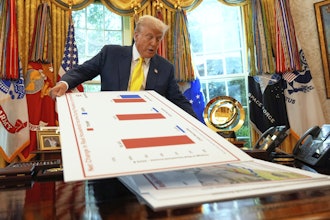
The U.S. economy slowed in the final three months of last year to an annual growth rate of 2.6 percent, the slowest pace since the beginning of 2018, as the government shutdown and other factors took a toll on growth. Economists believe growth has slowed even more in the current quarter.
Growth in the gross domestic product in the October-December quarter was down from a 3.4 percent gain in the third quarter, the Commerce Department reported Thursday. The government cited slower consumer spending as the biggest factor in the slowdown. The 35-day government shutdown shaved an estimated 0.1 percentage point from growth in the fourth quarter.
GDP growth for all of 2018 came in at 2.9 percent, the best showing in three years since 2015.
The current expansion, now in its tenth year, is the second longest in U.S. history. But it has featured the weakest annual growth rates of any recovery in the post-World War II period, with growth averaging just above 2 percent.
President Donald Trump often cited the weak growth rates during his 2016 presidential campaign, pledging to implement economic policies to boost growth to annual rates of 3 percent or better.
However, private economists believe that the 2.9 percent growth seen last year may represent the economy's high point for some time. Many are forecasting growth this year will slow to around 2.2 percent and slow even more in 2020. Some forecast the economy could dip into recession next year.
If the current expansion lasts beyond June of this year, it will become the longest in U.S. history, surpassing the decade-long recovery from 1991 to 2001.
In a separate report, applications for unemployment benefits, a proxy for layoffs, rose by 8,000 last week to a seasonally adjusted 225,000. That is still a low level by historical standards and suggests businesses are mostly holding on to their workers in a tight labor market. The unemployment rate in January stood at 4 percent, near a half-century low.
The 2.6 percent GDP growth rate in the fourth quarter was the slowest since a 2.2 percent rise in the first quarter of last year. That was followed by two strong quarters with gains of 4.2 percent in the second quarter and 3.4 percent in the third quarter. Trump has often cited those performances as evidence that his economic program of tax cuts, reductions in regulations and tougher enforcement of trade agreements was working.
Economists believe the $1.5 trillion tax cut that Trump got Congress to approve in December 2017 did boost growth last year, along with billions of dollars in added government spending on military and non-defense programs. However, they believe the impact of the tax cuts and increased spending will be fading this year and will contribute to a slowdown in growth.
For the current January-March quarter, many analysts believe growth could slow to below 2 percent.
The Commerce Department's GDP report Thursday had been delayed by a month because of the government shutdown. Because of the shutdown, the government is only going to produce two reports for fourth quarter GDP, rather than the normal three.
The report showed that consumer spending slowed to a still solid growth rate of 2.8 percent in the fourth quarter, down from 3.5 percent growth in the third quarter.
Business investment spending came in at a strong 6.2 percent annual rate, up from 2.5 percent in the third quarter. The trade deficit trimmed growth by 0.2 percentage points but that was less of a drag than the 2 percentage point cut in the third quarter.
Government spending grew at a rate of 0.4 percent, but non-defense spending fell at a rate of 5.6 percent, a drop that partially reflected the government shutdown.






















